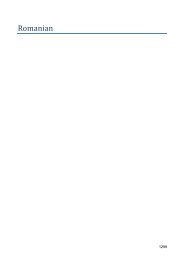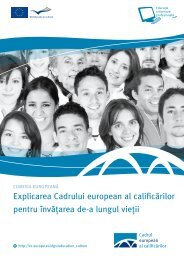Teaching and Assessing Soft Skills - MASS - Measuring and ...
Teaching and Assessing Soft Skills - MASS - Measuring and ...
Teaching and Assessing Soft Skills - MASS - Measuring and ...
You also want an ePaper? Increase the reach of your titles
YUMPU automatically turns print PDFs into web optimized ePapers that Google loves.
trained in the use of the rubrics <strong>and</strong> normally a sample of responses is assessed by at least<br />
two raters so that inter-rater reliability can be checked.<br />
Performance assessment<br />
“Performance-based assessment is a type of testing that calls for demonstration of<br />
underst<strong>and</strong>ing <strong>and</strong> skill in applied, procedural, or open-ended settings” (Baker, O’Neil, &<br />
Linn, 1993, p. 1210). Performance assessment has been used in judging activities that do not<br />
normally leave an artefact that could be evaluated later. Examples have included gymnastics<br />
<strong>and</strong> dance, but the act of making an object was also a performance that could be evaluated<br />
separately from any assessment of the object that was produced. Performance assessment<br />
has been extended to a wider range of activities, including science laboratory classes,<br />
medical diagnoses <strong>and</strong> building brick walls. In these cases, products existed that were<br />
evaluated, but soft skills are more likely to be observed in their execution during<br />
construction of the artefact than in the artefact that is produced. It is the act of producing,<br />
rather than the product, that is being judged.<br />
Performance assessment was characterised by the use of open-ended tasks with responses<br />
constructed by the student rather than being selected from defined options <strong>and</strong> by a focus<br />
on complex skills in a curriculum context, <strong>and</strong> were judged in terms of domain specific<br />
criteria rather than against a generalised trait (E. L. Baker et al., 1993, p. 1211). The last of<br />
these claims is a challenge to the generalizability of any inferences that may be drawn from<br />
a performance assessment. One goal of assessment is to judge <strong>and</strong> provide feedback about a<br />
specific activity, but if that feedback cannot be used in subsequent performances, it is of<br />
little value to the learner.<br />
Teacher/Holistic judgment<br />
Teacher judgment has featured prominently in the literature on assessment <strong>and</strong> has been<br />
shown to be central to almost all forms of assessment. An obvious exception is the multiplechoice<br />
format, although in that format, judgments are made when the tasks <strong>and</strong> response<br />
alternatives are chosen.<br />
Teacher judgement has been shown to work well in the school sector where teachers know<br />
students’ attributes well through frequent <strong>and</strong> close observation. Consistency of judgements<br />
within panels of teachers has been demonstrated. What cannot be shown is that this<br />
consistency extends across school boundaries. This means that students from different<br />
schools may be judged against different st<strong>and</strong>ards, <strong>and</strong> so individual achievement, assessed<br />
using this method, does not provide a basis for broad comparison.<br />
This method is unlikely to transfer to either the VET or higher education sectors where such<br />
close observation in a range of contexts does not occur. A trainer may monitor learners in an<br />
institutional classroom or workshop setting, but is unlikely also to see them in social or<br />
workplace settings. Similarly, workplace supervisors may observe individuals in that context,<br />
but not in others. The bases of judgements made by these raters will be restricted to a<br />
limited range of contexts.<br />
An issue raised in the literature reviewed above is a restriction of the knowledge of<br />
st<strong>and</strong>ards <strong>and</strong> their application to a community of assessment practitioners (Sadler, 1989).<br />
This is shown to have implications for feedback <strong>and</strong> for a role for students in self-<br />
125





